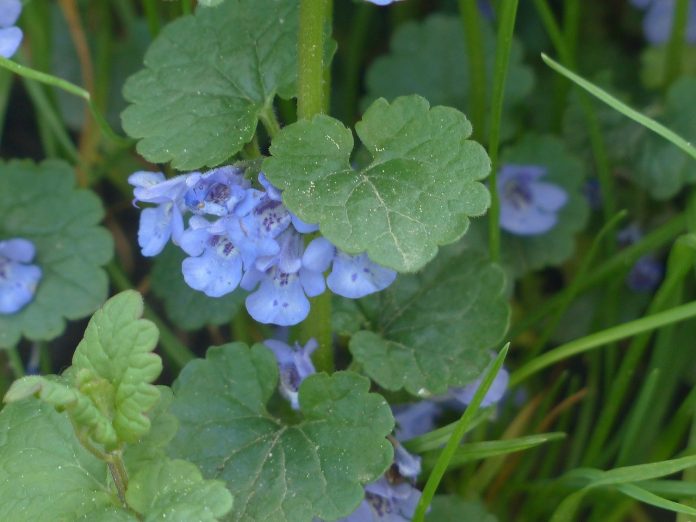The depth of my dad’s obsession with his lawn has always amused me. Living so far into a wooded lot that you can’t see his house from the road, his expectations are just shy of a golf course fairway. He maintains a strict regimen of annual seeding and fertilizing to keep the grass looking plush.
Late summer and early fall were not kind to his lawn. Between the weather and my mom over-fertilizing a few strips of lawn (whoops), he’s experienced a few setbacks. One major issue has been an influx of ground ivy. It’s moved in and thrived in every bare area. It’s so apparent it’s been a topic of conversation many evenings after work.
Ground ivy can take over for a number of reasons but it especially likes moist, shady areas, which makes it no surprise it’s taking root in my dad’s lawn. Living on a woodlot makes it hard to get grass established. When excessive rain and accidental over-fertilizing leave bald patches in the lawn broad-leafed weeds become established easily.
Getting rid of ground ivy
From a distance, ground ivy may be mistaken for clover because it has round leaves with rounded, toothed margins. However, ground ivy isn’t as benign as clover. It is regarded as one of the most common and most difficult weeds to manage in lawns. It is an aggressive, low-growing perennial evergreen with a square stem and vine-like root system. It spreads out along the soil surface, establishing roots at each node. Its extensive root system allows it to stick to the ground like velcro and makes it very hard to get rid of with weeding alone.
Weeding. Hand weeding to remove ground ivy is a good first line of defense but is often tedious because of the root system along the stem. If you don’t pull all of the rootlets, the plant will grow back. The best time to attempt to remove it by hand is after rain when the soil is looser.
Herbicides. Applying a broadleaf herbicide twice a year for 2-3 years is the best way to get rid of ground ivy in your lawn.
Herbicide applications should take place in the spring when the plant is flowering from March through May and in late fall from September to November when it is actively growing.
Use a combination broadleaf herbicide that contains:
- 2, 4-D (2,4-dichlorophenoxyacetic acid)
- Mecoprop or MCPP (2-[2methyl-4 chlorophenosy] propionic acid)
- Dicamba (3,6-dichloro-o-anisic acid)
Some herbicides that contain these chemicals include:
- Surge
- Trimec Classic
- Speed Zone
An alternate option is to use herbicides that contain triclopyr, such as Confront, Chaser, Battleship, Momentum and Weed-B-Gon purple label. Triclopyr is a chemical that’s known for managing hard-to-control weeds. Combinations of triclopyr and 2, 4-D can be very effective.
Other tips
- Do not apply herbicides to control ground ivy during the summer.
- Check herbicide labels for appropriateness for home use.
- Follow label instructions for herbicide application.
Maintaining lawn after removal
Reseed and spot-repair grass after ground ivy has been removed or treated. New weeds will quickly move into bare areas in your lawn. However, it’s less likely if new grass is planted.
If the area where the ground ivy was growing is shady, choose shade-tolerant grass to out-compete and prevent the future establishment of ground ivy.
The best way to prevent ground ivy infestations from returning is to maintain a healthy lawn.
- Don’t cut your grass any shorter than 3 inches high.
- Fertilize adequately in the spring and fall (2 lbs. nitrogen per 1,000 sq. ft.) and be careful not to over-fertilize.










